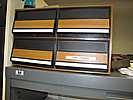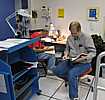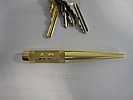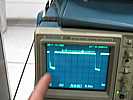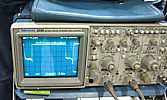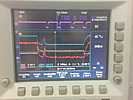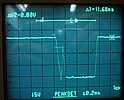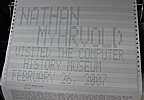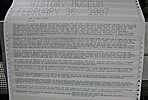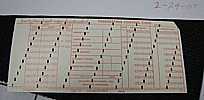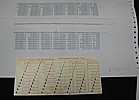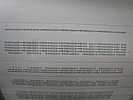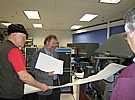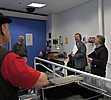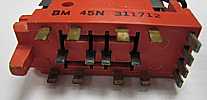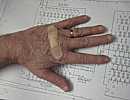Schedule February 2007
return to main 1401 Restoration Page
go to Team Bios
Contents:
Thu Feb 01 - Tape Team
I think that we can declare the TAU and first 729-V working. I am sure
that there are more marginal cards to be detected and replaced, but
errors are becoming more and more difficult to find using the existing
diagnostic set.
Rather than come in to the CHM on Thursdays, I plan to focus my effort
on completing the 1401 Tape Channel Analyzer. The data generators that
the Analyzer can provide would substantially help in our effort to
find/fix remaining tape subsystem intermittent errors. Its software
download capability also seems to be needed now.
Allen, the 729 still needs fine-tuning. (Skew adjustment and such.)
Contact me when you want to go in and make these adjustments.
Also...
Regards,
Sat Feb 03 - 1401 Demo Discussion with Senior Docents :-)) and Ripple Read :-((
I (Ed Thelen) listened to Jim Somers giving
ideas and future plans and interacting with 16 of "his" senior docents about the real world.
Also I discussed the
Also as we get closer to the time, I would love to talk through the issues like the frequency of demos
(taking wear-n-tear) on the machine into account, the number of desired demonstrators, composition of
the demo teams, and training for demonstrators.
Thanks again for all your work.
and Ripple Read Test :-(( Noon to about 4:00
Executive summary - Robert Garner owes me $0.25 - and if you don't want to read a long and sad tale,
stop right here and go watch the SuperBowl!!
The 1401 has stopped with no instruction (no bits at all - not even parity) in the op-code register.
Bob Feretich responded to the sad tale above with:
I can't explain how the "Bad Card" got back into the deck. I probably
should have destroyed them. I did not think that anyone would place a
card with "Bad Card" written on it back in a deck.
Each object card in the diagnostic decks contained the test case number,
revision code, and a card sequence number. The test case number for
Ripple Read is 1040. The revision code is a letter. (I have seen A
through D used.) The revision code of several diagnostic decks don't
match the listings in the Diagnostic manual. If the revision codes don't
match, then you cant trust the assembly listing to match the core image.
We have multiple versions of the diagnostic decks. For 1040, we have
both the A and B revisions. Some revisions are punched in a more human
readable format than others. I typically chose to punch the more human
readable revision. We didn't find the Diagnostic Manual until after we
punched many of the diagnostics.
The original Ripple Read deck had only 60 data cards. To provide a
longer time to scope problems, I replicated these data cards 10 times.
So our deck has about 600 data cards.
P.S. Allen and I plan to come in on Thursday to perform fine tuning
adjustments on the tape drive. We should be there unless his electrical
contractor takes longer than expected.
Regards,
Wed Feb 07 - general
The scope was to trigger on the drop of the clutch, and display rows 9,8,7,...12.
The deck of Group Mark (row 12, 7,8) cards was read. There was no current (and no hole) in row 9. Oddly, row 8 looked bouncy,
as though the brushes were bouncing - They should have long since quit bouncing as the circuit breaker was set to
enable current after the brushes contacted through the hole in column 8, and disable current before the brushes
were raised before the end of the hole. Sometimes it looked like a lot of noise. Rows 7 and 12 were better.
This interlock switch might be the cause of the strange total 1402 failure occasionally.
There is no warning indication when an interlock switch is open -
From John Van Gardner: Feb 10th
The early 1402s had Cunningham plunger type master CBs. They bounced a
lot and that why they came out with the Solar Cell CB unit. I installed
a couple of these on the early machines at Lockheed. This unit
consisted of a light bulb, photocell and disk. I don't recall ever
having any trouble with one of these units in a 1402 but a similar
arrangement was used in the 2321 data cell and they were vibration
sensitive. They finally cured that problem by replacing all the little
bulbs with a large automobile tail light source and fiber optic light
pipes to each detector assembly.
Also attached is a scan of page 180 and 181 of the 1401 Maintenance
Manual 225-6487-3 showing the scoping procedure and wave forms for the
CBs and brushes. The wave forms are a lot more clear in the manual than
the scan.
Van Gardner
Thu Feb 08 - Tape Team
Ripple Read
Tape Drive Fine Tuning Adjustments
We examined the drive's forward prolays start and stop timings. The
start timing was about 2x the maximum specification and contained about
1.5 milliseconds of jitter. The Card to Tape diagnostic seems to cause
more abrupt start stop activity due to its reading of a card between
tape actions. It seems logical that a start/stop issue would impact this
diag more than other diags. Allen adjusted the gaps so that both forward
timings were brought into spec.
We ran the Card to Tape diagnostic successfully, three times! The other
tape diagnostics also ran successfully.
Although no errors are currently being reported, we still plan to
check/adjust the drive's backwards timing and skew timing in a future
session.
Drive Unload and Rewind Problems
Regards,
Sat Feb 10 - 2nd Sat - Volunteer Day - free food ;-))
Tim found problems and fixed 4 sick ADB cards - 3 had intermittent/open collectors (the iron leads rusted through) and one
shorted transistor. Three more sick ADB cards await further trouble shooting with more switches to enable more test
conditions. He also fixed an open 1000 microhenry coil (open) in a BJ card from a 729 tape drive.
Tim would like a big roll of copper wicking (prefluxed with dry powder) - we have no more - I will pick up some from Fry's.
Wed Feb 14 - general
Wed Feb 21 - general
Sat Feb 24 - 4th Sat
Ron eventually found a permissive break relay that was supposed to put ground on the brush roll that was not
doing its job. Ron noted that
Ron is concerned that we maybe should refurbish a lot of relays.
Monday Feb 26 - special guest
Nathan also paid for the construction of the printing part of
the Babbage Difference Engine in the Science Museum in London.
We tried to do a Big Print demo for Al and friend, but after several
tries we gave up and we continued talking.
Wed Feb 28 - general
Thu Feb 01 - Tape Team,
Sat Feb 03 - 1401 Demo Discussion with Senior Docents and Ripple Read
Wed Feb 07 - general,
Thu Feb 08 - Tape Team,
Sat Feb 10 - 2nd Sat., - Volunteer Day - free food ;-))
Wed Feb 14 - general,
Wed Feb 21 - general,
Sat Feb 24 - 4th Sat.
Mon Feb 26 - special guest, Wed Feb 28 - general,
from Bob Feretich
TAU Debug Status - 2/1/07 (Grant and me)
We were able to verify the improved quality of the tape subsystem. Last
session we isolated and removed a noise generating delay line card.
Today, we were able to run the Backspace/Skip (5030), Move Tape (5040),
Load Tape (5050), and VRC Check (5080?) without errors. We then ran Card
to Tape (5000). One error was reported, but the 1402 card reader died
during the test. It would not even respond to the "non-process runout"
switch.
We need a new CPU logbook. The existing one is full.
Bob Feretich
> p.s. While your working on the analyzer, are you contemplating
> upgrading
> its firmware to upload ROPE/SIMH binaries into the 1401?
Yes. You should be able to boot a Rope object file froma PC.
Regards,
Bob
1401 Demo Discussion with Senior Docents :-))
I use the quoted "we" because "we" don't work!!
- Robert Garner brings smiles, bagels, and toys -
and clean the floor and benches
- I (Ed Thelen), in the words of Ron Williams,
am Captain Peacock of "Are You Being Served"
and do power supplies
and the workers get the mushrooms or something
Always that way - the world ain't fair -
Ya know, Jim Somers ain't no Hollywood leading man, tall dark and handsome -
but he really knows how to do a meeting :-)) - FYI - The following are images of his handouts.
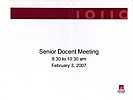
Cover

Page 1

Page 2

Page 3

Page 4
- Folks helped pass out my handouts :-))
I said that most of the equipment worked (except 4 of the 5 tape drives are being re-assembled)
- but we are having stability problems - things still fail too often :-)
and referred to the handout of Robert's Jan 19th Status Report
The Senior Docents were very interested and unusually polite -
Well OK, I had an audio recorder running ;-))
- keypunched card and printer demo.
- And also proposed demo of unit record equipment, maybe a separate specialized tour.
And the fact that we wish to present most of the 1401 and unit record equipment with plastic (see through)
skins.
[much laughter ;-))]
We can still buy them, about $0.016 each in boxes of 2,000 - nice 5081 style - $32/box
We have, Dag says "a million", cards with special printing - like inventory control -
Indeed - next version :-)) - the text is highly adaptable.
[It turns out that the URL uses both upper and lower case,
- and the 1403 can only do upper case -
- and UNIX (Internet servers) is so case sensitive.
So, next best thing is to GOOGLE for "1401 Restoration"
and the web site pops right up :-)) ]
could you have some pre-recorded sounds? Sounds like a great idea!!
Yes, some one has done that software in the past - maybe we can find it?
We are in prayer mode on this - we have tried to attract many people to learn the machine, but
they seem to - get a day job - get married - ...
Three people have stayed and are learning - one helps in trouble shooting the computer, the other
two trouble shoot defective cards.
[Some one else discussed time between order and delivery of the 1401 - including the fact that at
almost all of the installations unit record equipment was being replaced, and there were no
programmers hired. So the nine months between 1401 order and delivery were busy hiring/training
people and making programs - to be developed on local IBM service centers. This way,
the IBM machines on rent already had working programs - and were not sitting mostly idle
in program development mode.]
[Some one else mentioned that after people had existing computers and programmers, the replacement time
could be much shorter - but was sometimes 12 to 18 months in the hurried early days of the 360 series.]
[?Bill Worthington? said that his training as a customer programmer was 4 weeks, including 1 week of
{mag} tape programming - read/write/backspace
- that was on SPS, before AutoCoder {another assembler} was available.
[The time between order and delivery was as short as 2 weeks in the 1980s.]
(Some one said "Maybe 8 or 10 people?" ) We have about 10 regulars in the restoration.)
(Jim Somers will send the URL of this page to the senior docents.)
And the folks applauded :-))
Hi Ed,
The presentation on Saturday great. I agree with Robert that there should be a follow up meeting focused specifically on the demo. My recommendation is to wait until enough is ready to do a prototype demo
and then use the the group as a sounding board. We could look to do it on a 2nd or 4th Saturday when the
1401 team would be around working anyway. Keep my in the loop on progress so that I can schedule the time.
Jim
The afternoon was so scrambled that I am referring from notes that I took in desperation!
What can be wrong?
Patch what? We hauled out the listing and I looked on line to see if we have a copy there.
We have a Diagnostics Page here, and the first hundred
cards listed here (10,000 bytes) and the noisy
.pdf of the 1040B test in the diagnostics book (2.2 megabytes)
And we notice that the listing is for 1040B and the deck is labeled 1040A.
How can that happen? - it seems impossible.
I count the successful cards and notice that one card has ink on it "Bad Card" - what is this?
We notice that this card is identical to the first test card in the deck, the ripple pattern
has come full circle, and is starting again.
Card "1040A 27" in the listing. - Location 492 in the .pdf - What is this? We load the program
and halt before executing the program - and "XXX"s are in fact in the address part of the compare instruction.
The address is set before execution to the start of the expected preset ripple pattern in memory.
Before index registers a person had to do that to index through memory. The technique was so common that the
LGP-30 (and other early machines) had in instruction to set the address portion of an instruction.
Welcome to self-modifying code. - The XXX helps the FE know that this is to be replaced :-|
Ron, knowing that I am trying to win that $0.25 bet, tells me that he will charge me $0.25
The deck listing had no surprises.
I become convinced that there is a programming/CPU bug associated with restarting the reference ripple pattern
in memory, the test deck looks just fine inspite of the "bad card" notation.
We decide that the day is too long for us - and lock up.
The Ripple Read bad card notation is probably mine. I found 2
mispunched cards that we received from Cardamation. One in Ripple Read
and one in Move Tape (I wrote them up in the log book.) The one in
Ripple Read had slightly misaligned columns in the right half of the
card. I duplicated the card on the key punch, put the new card in the
deck. I marked the bad card with sharpie marker and put it on the 1406
storage unit. (Both bad cards were on the 1406.)
Bob
Ron observed that there seemed to be more dropped reads of row 8 than other rows in the Group Mark test.
The 1402 as purchased had 6 of 8 interlock switches by-passed. Only the two for the top panels were enabled.
Ron Williams, Bill Flora and Frank King adjusted the remaining two to work reliably.
Ed Thelen remembers there was an interlock warning light in his Army radar system -
then the game was to find which of about 20 was open :-((
I see from the web site that you scoped the current limiting resistors [on Feb 8th]
and it looked like the brush maybe bouncing. This is possible and one
cause is the brush rubbing on the phenolic separator. We had a tool to
bend individual brushes so this didn't happen. It didn't cause as much
trouble on the 1402 as it did later when it was developed into the 2540
running at 1000 cpm. I am attaching a .PDF file of two pages from the
CE Tools Handbook S131-0075-3. The upper right tool is the one. It has
a slot in the lower end to slip over the brush. A skinny pair of long
nose pliers could do the same thing.
from Bob Feretich
TAU and 729 Debug Status - 2/8/07 (Allen P., Ron W., and me)
First I ran Ripple Read (1040) per Robert's request. It ran
successfully, however the Reader Check indicator was on by the end of
the run. Ron told me about a patch he applied to the deck. The problem
he fixed was clearly an error. A branch instruction was branching into
the middle of another instruction. I don't know how the bad branch would
have effected the diagnostic.
We ran the full set of tape drive diagnostics (5000 - 5080). The results
were similar to last week. Card to Tape (5000) reported three errors.
The other diagnostics ran without error.
The drive's take-up capstan-in microswitch was failing intermittently
today. (This impacts Load, Rewind and Unload operations.) Allen adjusted
the switch and had it working last week. When the capstan is "in", the
rear of the capstan shaft is supposed to be close enough to a magnet on
the microswitch to trigger the switch. The magnet pulls microswitch's
lever forward. If the magnet was stronger, the lever could move forward
and still not touch the capstan shaft. My guess is that the magnet on
the microswitch has weakened over time and now doesn't have the strength
to reliably trigger the switch. If the switch is adjusted further
forward, the shaft gets close enough to attract the magnet, but the
lever does not have enough travel throw the switch. The capstan shaft
gets hot during operation. Since the magnet now touches the capstan
shaft when the shaft is in, it is likely that the shaft's heat is
further degrading the magnet. I think that we need to find a replacement
switch, strengthen the magnet on the existing switch, or replace it with
a modern position sensor.
Bob
The card decks converted from image files via Bob Feretich and Cardamation arrived - robustly packaged.
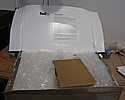
Dan McInnis's 1401 demo deck ran just fine.
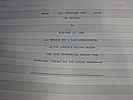
card # 68 had some characters with correct printing and wrong punches!?! and was badly mis-registered.
The card holes should be in the black fields (now barely visible).
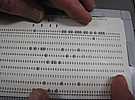
We never did get it punched so that it would read in correctly. :-|
- I removed many cards that blanked large fields 40 characters at a time
Will try Pi again next Wednesday
Ron Williams wowed us by showing these drawings of what the logic levels should be for some ADB card circuits. He found at least
one more sick ADB card.

- missing hole in a card
- a hole in a card being fed into the punch
"Just like there were no punch read brushes in there at all".
Jeff Stutzman came in after lunch with some aluminum angle "iron" and a slim fluorescent lamp, both to help
trim and display the 077 collator.
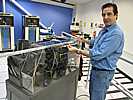
The program ran over the noon hour again, but did not complete - again. We took a memory dump using
front panel switches - and analysis continues - Bill Flora figures the program *must* be in an infinite loop,
Ed Thelen has seen the program run correctly under simulation (takes 1 second on a fast PC) and
he hopes - something else .
Viewing the memory dump, the processing is about 1/3 done. I will try again at some idle time.
Photos from last month -


When we came back from lunch (Bagels and such) there was a burning smell as we approached the 1401 entrance.
We searched high and low. It looked like a bunch of blood hounds sniffing all over the place. Dave Dial's crew (building management)
even checked the florescent light fixtures for blown ballast transformers.
Eventually
Dag Spicer (who was in the room to approve removing rust from the 729 Model II) checked inside the 083 to find the
resonance capacitor had split open and blown oil and such all over the place inside the sorter around the power supply area.
It's a couple of microfarads, 1600 volts DC, 660 volts AC 60 cycle. Grant looked it up in a book and thinks he can find a replacement.
The oil has been cleaned up with soap and "a mile and a half of paper towels".
Allen wrote "Little, little round magnets 3/8�� diameter with 1.1lbs of �pull� are hazardous material and are not
allowed to be transported on an airplane. They must travel via surface transportation. So no �over night delivery��
Frank King reports the pain is not bad unless you cough or move.
Part of the physical therapy is that you are required to cough periodically.
Boredom can get bad. Chuck and Frank will advise when and where to visit -
but no data was getting into the 1401 memory.
The 1401 blanks memory 001 through 080 as part of the card read cycle, but after a card was "read",
that area was still blank :-((
- the relay points were pitted
- the relay external contacts (to the socket) were badly corroded.
The relay now functions, but Ron is uncertain which (if either) of the above conditions caused the problem.
Would that include polishing/plating/? the external contacts?
Tim did not bring in his in-circuit tester this time :-((
http://en.wikipedia.org/wiki/Nathan_Myhrvold
He seems interested in the Babbage machine
in the sense that he paid for the construction of a second
machine - for his own use.
He didn't even demand the sacrifice of my first
born child.
The demo was to be for maybe 10 minutes about 3:30 PM Monday -
Al was widely informed about computers and an ideal guest. :-))
Grant got two series capacitors @ 4 ufd each were used because replacement 2 ufd 660 volt capacitors do not seem available.
Grant also supplied the electrical lugs and mounting straps and made a mounting bracket for Frank King to drill.
Didn't Frank do a neat job?
And would you believe - the output voltage from the replaced resonant circuit is about 1% off nominal -
likely better than originally manufactured. :-))

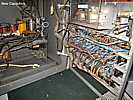
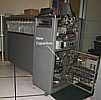


- Frank sent this more detailed report.
Thanks to Grant and Ed the 083 is running. (a little jamming and
missorting, But running). The power supply has been restored to normal.
The capacitors that Grant purchased along with the mounting brackets he
sent over made the installation a snap. Chuck and I drilled a few holes and
mounted them right where the old one was located.
The old capacitor was a 4uf, rated @ 650 VAC. The new ones were 2uf each,
rated @ 370VAC. When hooked in series the voltage across each capacitor
was 244.5 and 245.0 VAC respectively. Ed, Chuck and I agreed that was
close enough. :-)
- the ripple read test can pass 500 cards error free (free run - 800 cards/minute)
- the BigPrint deck (about 200 cards) runs quite reliably (clutch action - about 400 cards/minute
Go to March 2007
go to Team Bios
